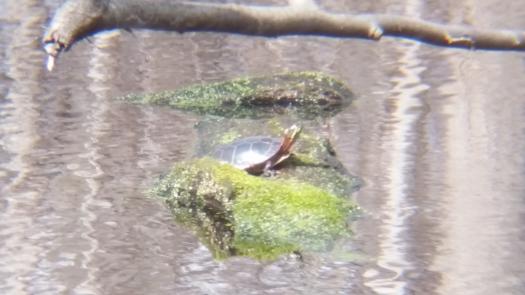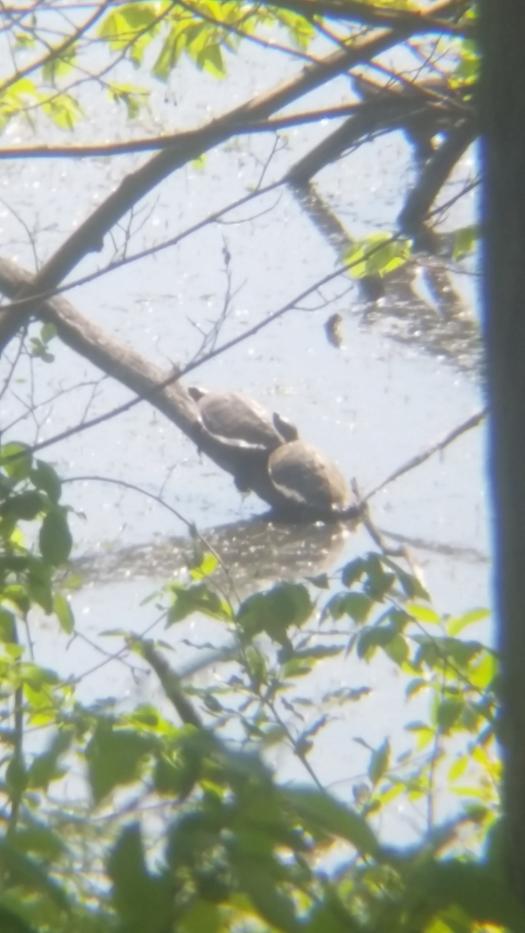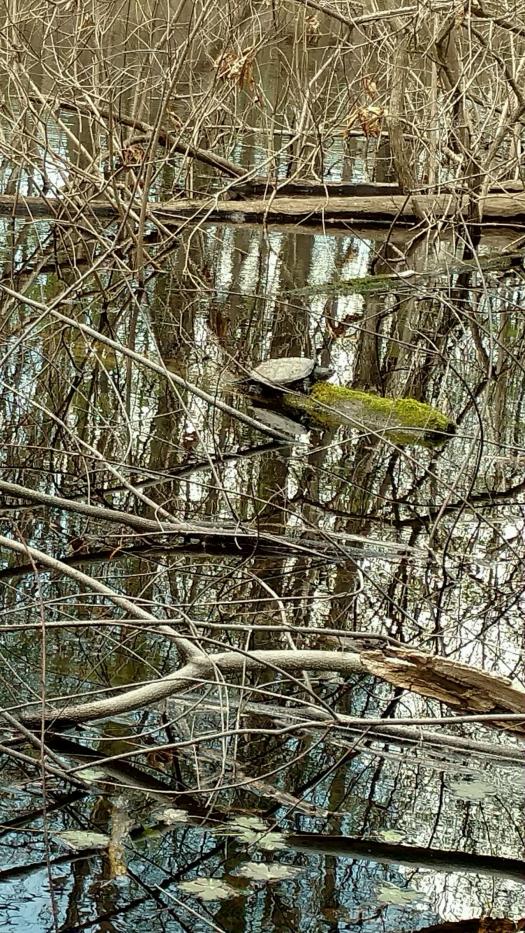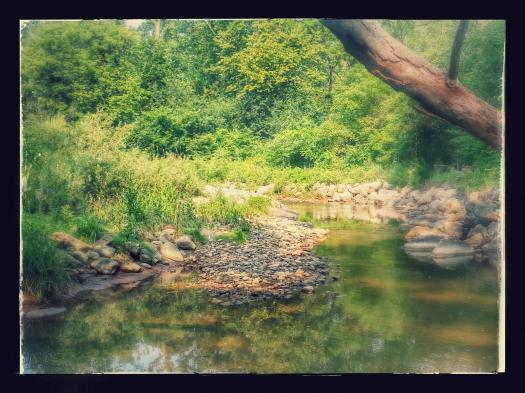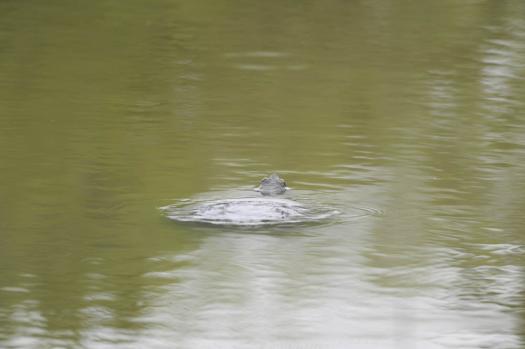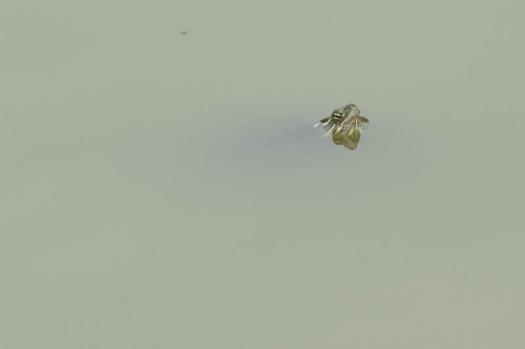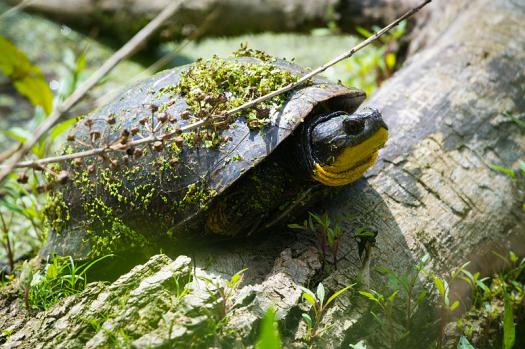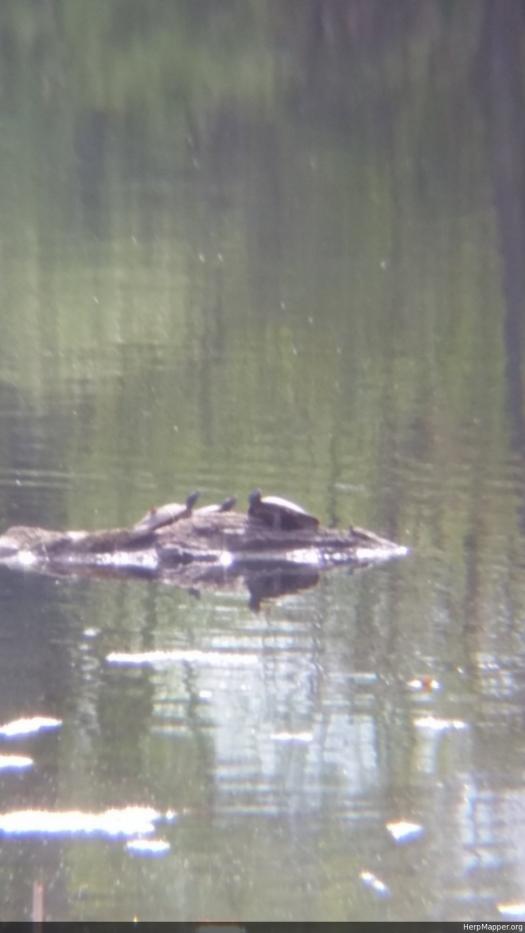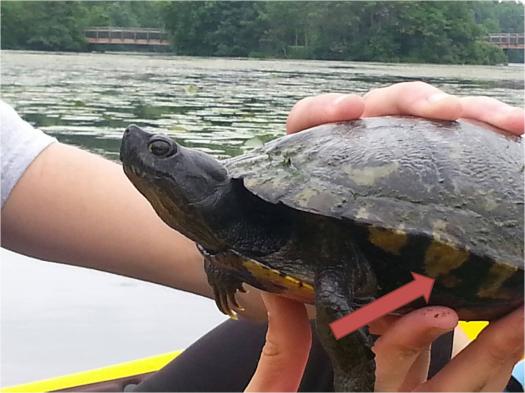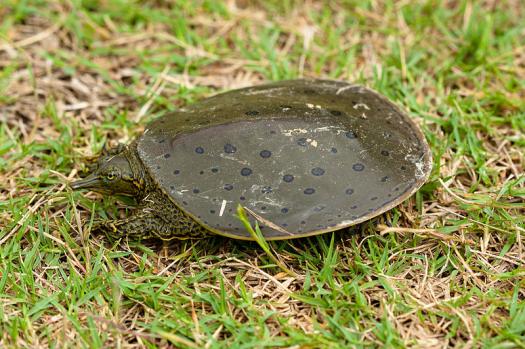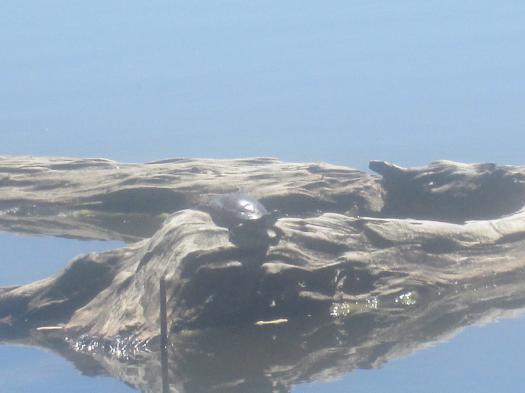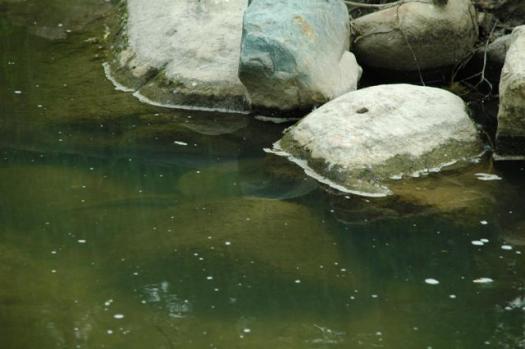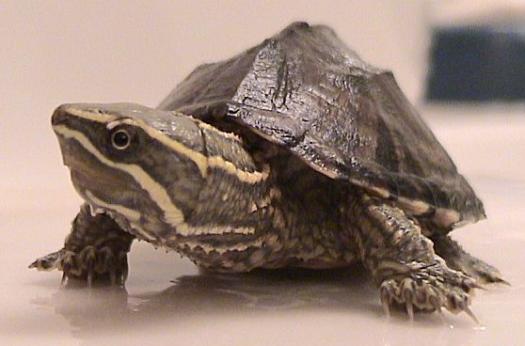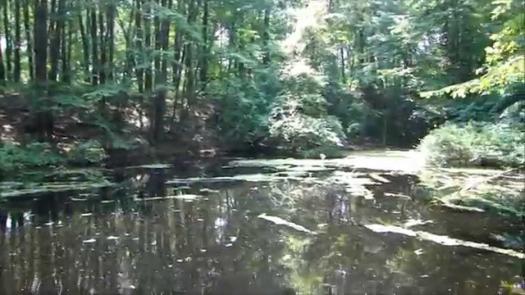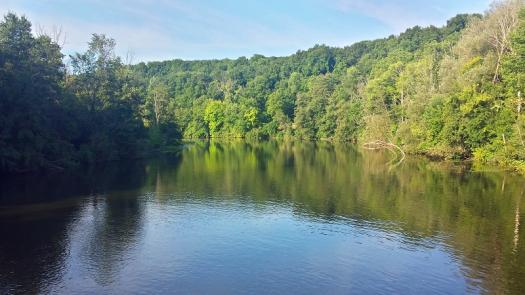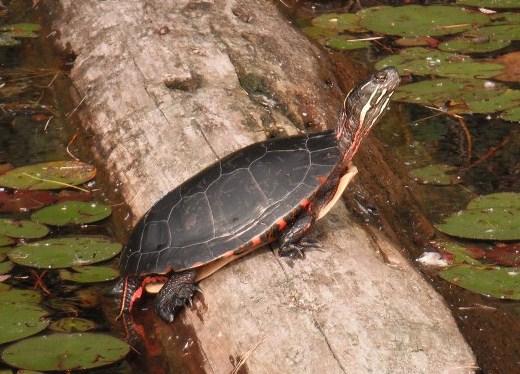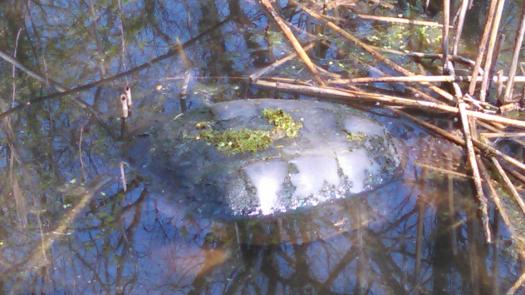Nap Turtle ID Quiz

Test your local turtle identification and knowledge! There are two types of questions in this quiz:
1. Identification questions - These are multiple choice questions that include a turtle picture and a hint about a distinctive characteristic or behavior. Note that somewhat ambiguous pictures were selected on purpose to replicate identification in the field.
2. Knowledge questions - These questions ask you to check which turtle(s) is relevant to what is being asked.
At the end of the quiz, your answers will be scored and the correct answers shown.
Good luck and feel free to assess your knowledge as many times Read moreas you'd like!
- 1.
Hint: Smooth, dark shell and head neck coloration is distinctive to this turtle
- A.
Common Map Turtle
- B.
Red-eared Slider
- C.
Midland Painted Turtle
- D.
Snapping Turtle
Correct Answer
C. Midland Painted TurtleExplanation
The Midland Painted Turtle is the correct answer because it has a smooth, dark shell and distinctive head and neck coloration. This turtle is known for its vibrant red and yellow stripes on its head and neck, which make it easily identifiable. The other options do not have the same characteristics mentioned in the hint. The Common Map Turtle has a patterned shell, the Red-eared Slider has a different coloration, and the Snapping Turtle has a rough shell.Rate this question:
-
- 2.
Hint: Large turtle with prominent flaring (upturning of shell) at back of shell.
- A.
Common Map Turtle
- B.
Red-eared Slider
- C.
Midland Painted Turtle
- D.
Snapping Turtle
Correct Answer
A. Common Map TurtleExplanation
The Common Map Turtle is the correct answer because it is a large turtle with a prominent flaring at the back of its shell. This flaring, also known as an upturning of the shell, is a distinguishing characteristic of the Common Map Turtle.Rate this question:
-
- 3.
Hint: Robust turtle with flat shell and long tail
- A.
Common Map Turtle
- B.
Red-eared Slider
- C.
Midland Painted Turtle
- D.
Snapping Turtle
Correct Answer
D. Snapping TurtleExplanation
The snapping turtle is the correct answer because it is a robust turtle with a flat shell and a long tail. The other options, such as the Common Map Turtle, Red-eared Slider, and Midland Painted Turtle, do not fit this description. The snapping turtle is known for its aggressive nature and powerful jaws, making it distinct from the other turtles listed.Rate this question:
-
- 4.
Which turtle(s) would you expect to find in stream habitats?
- A.
Common Map Turtle
- B.
Red-eared Slider
- C.
Midland Painted Turtle
- D.
Snapping Turtle
- E.
Musk Turtle
- F.
Soft-shelled Turtle
- G.
Blanding's Turtle
- H.
Box Turtle
Correct Answer(s)
A. Common Map Turtle
D. Snapping TurtleExplanation
The Common Map Turtle and Snapping Turtle are the turtles that are commonly found in stream habitats. These turtles are adapted to live in water and are often found in streams, rivers, and other aquatic environments. They have specific physiological and behavioral adaptations that allow them to thrive in these habitats, such as streamlined bodies for efficient swimming and the ability to hold their breath for extended periods of time. On the other hand, the other turtle species mentioned in the options are not typically associated with stream habitats and are more commonly found in other types of environments.Rate this question:
-
- 5.
Hint: Light yellow stripe down the center of each shell scute (scale) and red stripe along head and neck
- A.
Common Map Turtle
- B.
Red-eared Slider
- C.
Midland Painted Turtle
- D.
Snapping Turtle
Correct Answer
B. Red-eared SliderExplanation
The correct answer is Red-eared Slider. This turtle species can be identified by the presence of a light yellow stripe down the center of each shell scute and a red stripe along the head and neck.Rate this question:
-
- 6.
Hint: Larger turtle that is actually basking while swimming along the surface. This is a somewhat unique behavior of this turtle.
- A.
Common Map Turtle
- B.
Red-eared Slider
- C.
Midland Painted Turtle
- D.
Snapping Turtle
Correct Answer
D. Snapping TurtleExplanation
The snapping turtle is the correct answer because it is known for its unique behavior of basking while swimming along the surface. This behavior sets it apart from the other turtle species listed.Rate this question:
-
- 7.
Hint: Smaller sized turtle with notable head coloration
- A.
Common Map Turtle
- B.
Red-eared Slider
- C.
Midland Painted Turtle
- D.
Snapping Turtle
Correct Answer
C. Midland Painted TurtleExplanation
The Midland Painted Turtle is the correct answer because it is a smaller sized turtle with notable head coloration. This turtle species is known for its vibrant and distinct markings on its head, which make it easily recognizable. The other options, such as the Common Map Turtle, Red-eared Slider, and Snapping Turtle, do not have the same notable head coloration as the Midland Painted Turtle.Rate this question:
-
- 8.
Hint: Wetland habitat turtle with distinctive yellow neck coloration and yellow flecked shell
- A.
Musk Turtle
- B.
Soft-shelled Turtle
- C.
Blanding's Turtle
- D.
Box Turtle
Correct Answer
C. Blanding's TurtleExplanation
Blanding's Turtle is the correct answer because it is a wetland habitat turtle that has a distinctive yellow neck coloration and a yellow flecked shell. The other options, Musk Turtle, Soft-shelled Turtle, and Box Turtle, do not have these specific characteristics.Rate this question:
-
- 9.
Hint: If you look closely, you will notice this turtle's white colored beak juxtaposed against its dark skin
- A.
Common Map Turtle
- B.
Red-eared Slider
- C.
Midland Painted Turtle
- D.
Snapping Turtle
Correct Answer
A. Common Map TurtleExplanation
The Common Map Turtle is the correct answer because if you look closely, you will notice this turtle's white colored beak juxtaposed against its dark skin. This feature is distinctive to the Common Map Turtle and helps to identify it from the other turtle species listed.Rate this question:
-
- 10.
Hint: This larger turtle was captured at Gallup Park in 2015 and has lost the ability to produce color pigmentation, which generally happens in older turtles. However, the black on yellow blotching of the shell bridge (note the arrow) is typical of this species.
- A.
Common Map Turtle
- B.
Red-eared Slider
- C.
Midland Painted Turtle
- D.
Snapping Turtle
Correct Answer
B. Red-eared SliderExplanation
The correct answer is Red-eared Slider because the hint mentions that the larger turtle in question was captured at Gallup Park in 2015 and has lost the ability to produce color pigmentation, which is a characteristic of older turtles. The black on yellow blotching of the shell bridge, indicated by the arrow, is also typical of Red-eared Sliders. This information aligns with the characteristics and behavior of Red-eared Sliders, making it the correct answer.Rate this question:
-
- 11.
Hint: Rare turtle in Ann Arbor that is pancake-shaped with a snorkel-like nose.
- A.
Musk Turtle
- B.
Soft-shelled Turtle
- C.
Blanding's Turtle
- D.
Box Turtle
Correct Answer
B. Soft-shelled TurtleExplanation
The soft-shelled turtle is the correct answer because it is a rare turtle found in Ann Arbor that has a pancake-shaped body and a snorkel-like nose. This turtle is known for its soft shell, which sets it apart from other turtle species.Rate this question:
-
- 12.
Hint: Note the shape of the shell
- A.
Common Map Turtle
- B.
Red-eared Slider
- C.
Midland Painted Turtle
- D.
Snapping Turtle
Correct Answer
C. Midland Painted TurtleExplanation
The Midland Painted Turtle is the correct answer because it is the only turtle species listed that has a shell shape that can be distinguished from the others. By noting the shape of the shell, it is possible to identify the Midland Painted Turtle as the correct option.Rate this question:
-
- 13.
Hint: Large turtle walking along the bottom of a stream or pond
- A.
Common Map Turtle
- B.
Red-eared Slider
- C.
Midland Painted Turtle
- D.
Snapping Turtle
Correct Answer
D. Snapping TurtleExplanation
The snapping turtle is the correct answer because it is known to be a large turtle that can be found walking along the bottom of a stream or pond. Snapping turtles are known for their aggressive nature and powerful jaws, making them distinctive among other turtle species.Rate this question:
-
- 14.
Hint: Small turtle with large beak and shell with three peaks. Extremely elusive turtle that is somewhat nocturnal. It is rarely found in Ann Arbor except when surveying with traps.
- A.
Musk Turtle
- B.
Soft-shelled Turtle
- C.
Blanding's Turtle
- D.
Box Turtle
Correct Answer
A. Musk TurtleExplanation
The correct answer is Musk Turtle. This small turtle is known for its large beak and shell with three peaks. It is extremely elusive and somewhat nocturnal, making it difficult to find. However, it is occasionally found in Ann Arbor when surveying with traps.Rate this question:
-
- 15.
Which turtle(s) would you expect to see in this wetland habitat? Remember that some turtles may prefer more than one habitat type.
- A.
Common Map Turtle
- B.
Red-eared Slider
- C.
Midland Painted Turtle
- D.
Snapping Turtle
- E.
Musk Turtle
- F.
Soft-shelled Turtle
- G.
Blanding's Turtle
- H.
Box Turtle
Correct Answer(s)
B. Red-eared Slider
C. Midland Painted Turtle
D. Snapping Turtle
E. Musk Turtle
G. Blanding's Turtle -
- 16.
Which turtle(s) would you expect to observe on a canoe trip along the Huron River and its fringe (edge) wetlands.
- A.
Common Map Turtle
- B.
Red-eared Slider
- C.
Midland Painted Turtle
- D.
Snapping Turtle
- E.
Musk Turtle
- F.
Soft-shelled Turtle
- G.
Blanding's Turtle
- H.
Box Turtle
Correct Answer(s)
A. Common Map Turtle
B. Red-eared Slider
C. Midland Painted Turtle
D. Snapping Turtle
E. Musk Turtle
F. Soft-shelled Turtle -
- 17.
Which turtle(s) would you expect to see basking outside of the water?
- A.
Common Map Turtle
- B.
Red-eared Slider
- C.
Midland Painted Turtle
- D.
Snapping Turtle
- E.
Musk Turtle
- F.
Soft-shelled Turtle
- G.
Blanding's Turtle
- H.
Box Turtle
Correct Answer(s)
A. Common Map Turtle
B. Red-eared Slider
C. Midland Painted Turtle
G. Blanding's TurtleExplanation
Common Map Turtles, Red-eared Sliders, Midland Painted Turtles, and Blanding's Turtles are the turtles that you would expect to see basking outside of the water.Rate this question:
-
- 18.
Which turtle(s) are you most likely to observe basking while swimming?
- A.
Common Map Turtle
- B.
Red-eared Slider
- C.
Midland Painted Turtle
- D.
Snapping Turtle
- E.
Musk Turtle
- F.
Soft-shelled Turtle
- G.
Blanding's Turtle
- H.
Box Turtle
Correct Answer(s)
D. Snapping Turtle
F. Soft-shelled TurtleExplanation
Snapping turtles and soft-shelled turtles are most likely to be observed basking while swimming. Basking is a behavior commonly seen in turtles where they rest or sunbathe on logs or rocks, often while partially submerged in water. Snapping turtles and soft-shelled turtles are known for spending a significant amount of time in the water and are more likely to engage in basking behavior compared to other turtle species listed.Rate this question:
-
- 19.
What are the four most common turtles in Ann Arbor?
- A.
Common Map Turtle
- B.
Red-eared Slider
- C.
Midland Painted Turtle
- D.
Snapping Turtle
- E.
Musk Turtle
- F.
Soft-shelled Turtle
- G.
Blanding's Turtle
- H.
Box Turtle
Correct Answer(s)
A. Common Map Turtle
B. Red-eared Slider
C. Midland Painted Turtle
D. Snapping TurtleExplanation
The correct answer is Common Map Turtle, Red-eared Slider, Midland Painted Turtle, and Snapping Turtle. These four species are the most commonly found turtles in Ann Arbor.Rate this question:
-
Quiz Review Timeline +
Our quizzes are rigorously reviewed, monitored and continuously updated by our expert board to maintain accuracy, relevance, and timeliness.
-
Current Version
-
Mar 21, 2023Quiz Edited by
ProProfs Editorial Team -
May 24, 2016Quiz Created by
Pterry0404
 Back to top
Back to top



